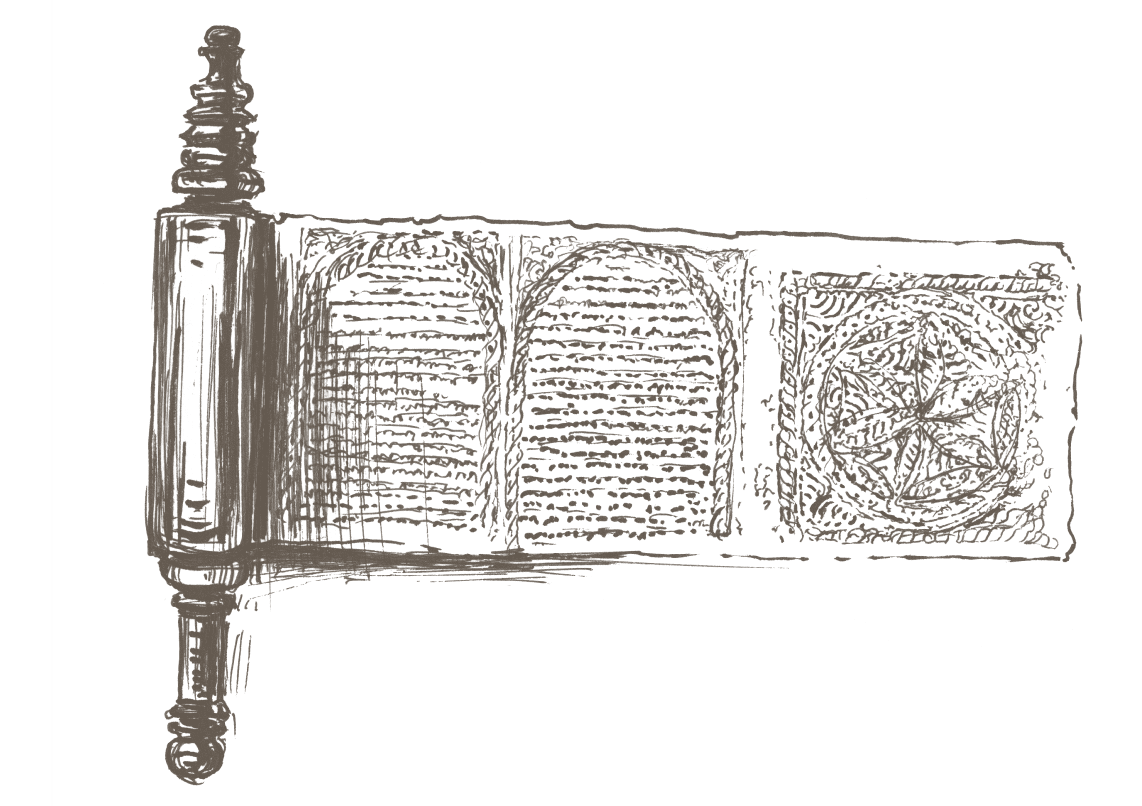Hebrew is a Semitic language within the Afro-Asian family of languages.
Language
The Lord's Prayer in Medieval Hebrew (Avinu Yitqadesh, a rabbinic Hebrew translation of the Lord’s Prayer by Shem Tov ibn Shaprut, 14th c.)
אָבִינוּ [שֶׁבַּשָּׁמַיִם]
יִתְקַדֵּשׁ שִׁמְךָ
וְיִתְבָּרֵךְ מַלְכוּתֶךָ
רְצוֹנְךָ יִהְיֶה עֲשׂוּי בַּשָּׁמַיִם וּבָאָרֶץ
וְתִתֵּן לַחֲמֵנוּ תְּמִידִית.
וּמָחוֹל לָנוּ חַטֹּאתֵינוּ
כַּאֲשֶׁר אֲנַחְנוּ מוֹחֲלִים לַחוֹטְאִים לָנוּ
וְאַל תְּבִיאֵנוּ לִידֵי נִסָּיוֹן
וְשָׁמְרֵנוּ מִכָּל רַע
אָמֵן.
The characteristic feature of Hebrew is its relatively solid consonant root which carries the basic meaning of the word. By adding vowels, prefixes and suffixes, the meaning of the word can be changed.
Hebrew was spoken natively by the Israelites and remained in active use until around 200 CE. Hebrew was revived as an active language during the 19th century.
Like most languages, Hebrew has gone through several stages of development. Medieval Hebrew builds on its earlier incarnations - Biblical and Mishnaic Hebrew. Due to historical shifts, the medieval form of Hebrew (roughly from 500 to 1500 CE) was not a spoken vernacular language for most people. In the Middle Ages, most of the Jews spoke the language of the place where they lived or later used other Jewish languages such as Ladino or Yiddish.
Although medieval Hebrew was used primarily for Jewish religious, legal, scholarly, and literary expression and often was not the language of everyday communication, it did not become a dead language. This is mainly because Hebrew was always a liturgical language, so prayers and regular readings from the Torah, as well as liturgical poetry, were publicly read and recited in Hebrew. Thanks to this, the development of Hebrew was not interrupted even at the phonological level.
In addition, during the medieval period many new words were added to the language in the fields of science, philosophy and religion. Some of these were created by giving new meanings to old roots, others were based on existing Hebrew words that were placed in new contexts. Other words penetrated from foreign languages, especially from Greek and Arabic.
Script
The square script
The primary script of medieval Hebrew is the square or Assyrian script. This script has been the standard form for most written Hebrew texts since the 5th century BCE. Characterised by its sharp, angular letters, the square script was used for writing wide range of texts including the Bible, Jewish liturgical texts, philosophical or scientific works, and poetry. During the Middle Ages, the square script became more rounded and stylised than its earlier forms. This change reflected the influence of the Arabic script and the more cursive styles of writing used by professional Jewish scribes.
The Rashi script
Probably the most famous semi-cursive Hebrew script is the Rashi script, named after Rabbi Solomon ben Isaac (1040-1105) and is characterised by more rounded and connected letters. However, Rashi himself did not use this type of script, and it bears his name because Rashi’s works are usually printed with commentaries and annotations in this particular typeface.Thus, the Rashi script was widely used for writing commentaries and glosses in order to distinguish them from the main text. The Rashi script became widespread in the Jewish intellectual world of medieval Europe, particularly in Germany and France.
The Ashkenazic and Sephardic scripts
The Ashkenazic script was used mainly in Central Europe and was characterised by its angular and condensed letters. The Ashkenazic script was used for religious texts, including prayer books, Talmudic commentaries, and codes of Jewish law.
On the other hand the Sephradic script used in Spain, North Africa, and the Middle East was more rounded, elegant and fluid than the Ashkenazic script. This script was used for both formal and informal documents and was also used for Jewish religious manuscripts, legal texts, and poetry.
Literature
A significant part of medieval Hebrew literature consists of religious texts. These include biblical commentaries, legal works and religious poetry. However, secular Hebrew literature such as philosophical treatises, scientific works and historical writings also flourished.
Sefer Mitzvot Gadol, composed during the second half of the 13th century in France by Moses of Coucy, lists the 613 commandements contained in the Torah. Based on the Mishneh Torah by Maimonides, Sefer Mitzvot Gadol marks the penetration of Sephardic customs into Ashkenazic legal works. Its great influence as a legal source and guidebook is evidenced by the large number of surviving manuscripts and the many commentaries that the work inspired.
Shulchan Aruch, 1563, Safed, Ottoman Syria, is one of the most important legal codes of Judaism written by the Sephardic Rabbi Joseph Karo. The work is written in Hebrew and follows the legal rulings of earlier Jewish authorities such as Maimonides, Solomon ibn Adret and the Talmud.
Sefer Hasidim, late 12th-early 13th century, Rhineland. Traditionally the authorship of Sefer Hasidim has been attributed to Rabbi Judah the Pious, one of the major figures associated with a circle or movement of German Jewish pietists. However, scholarly research has shown that Judah the Pious was not the only author of the text. This compendium of traditions contains ethical, halakhic, midrashic, mystical, and even philosophical material. Presented as a guidebook for the practice of Jewish piety, it consists mainly of parables, homilies, and exempla.
Mishneh Torah, composed between 1170-1180 in Egypt. This code of rabbinic Jewish religious law was written by Maimonides. Mishneh Torah consists of fourteen books and is the only medieval work that details all of Jewish beliefs and religious practice, including the laws that are only applicable when the Temple in Jerusalem is in existence.
Between the 10th and 12th centuries, Jewish scholars in Al-Andalus (Muslim Spain) composed Hebrew poetry, both sacred and secular, in a wide range of literary forms, from devotional hymns and erotic verses to prophesies of doom and dissolution. This period, often called the 'Golden Age' of Iberian Jewish culture, produced some of the greatest poets in Jewish literary history, including Dunash ben Labrat, Solomon ibn Gabirol, and Judah ha-Levi, whose work reflect the influence of Arabic poetic traditions.
Samuel ha-Nagid, one of the leading figures of the Golden Age of Hebrew poetry, also drew inspiration from his roles as prime minister of the kingdom of Granada and commander of its Muslim army. In one of his poems, he writes:
It’s heart that discerns
between evil and good,
so work to develop your heart.
How many are there
who heartlessly destroy,
and think their destruction a start?
Importance
Other Jewish languages
The development of new languages such as Yiddish and Ladino among Jewish communities is closely linked to the historical and social contexts in which Jewish populations lived and to the different regions in which they were located. After the destruction of the Second Temple in Jerusalem (70 CE) and the subsequent dispersion of the Jews, Jewish communities found themselves living in different parts of the world, from the Iberian Peninsula to Eastern Europe, North Africa, the Middle East, and beyond. The diaspora was one of the main factors contributing to the creation of new languages, as Jewish communities adapted to their local environment while maintaining their distinct cultural and religious identities.
Yiddish
Yiddish is a language historically used by the Ashkenazi Jews. Initially it was a spoken language, but later it became also a literary language as well. Yiddish is a mixture of High German, Hebrew and Aramaic, which slowly absorbed elements of Slavic dialects. It originally developed as a vernacular language spoken by the Jews living in German-speaking countries. Traditionally, Yiddish was written using the Hebrew alphabet. The first surviving text in Yiddish is considered to be a short rhymed blessing in the so called Mahzor of Worms (1272). After the second half of the 13th century Yiddish spread eastwards - to Bohemia, Moravia, Poland and Lithuania. Its unique blend of Germanic, Slavic, and Hebrew elements makes it an exceptional linguistic artefact, reflecting centuries of Jewish life in Eastern Europe and beyond.
Ladino
Ladino (Judeo-Spanish) is a Romance language based on Old Spanish with elements of Hebrew and written in the Spanish Hebrew cursive script, the Solitreo. Initially, Ladino was used by Jews living on the Iberian Peninsula, but after the expulsion of the Jews from Spain in 1492, Ladino migrated and spread with the exiles to the Ottoman Empire as well as to the Netherlands, France and Morocco. Like Yiddish, Ladino was influenced by the regions in which the emigrating Jews settled. The first book printed in Ladino was a work of Jewish religious law concerning the ritual slaughter of animals.
Judeo-Arabic
Judeo-Arabic refers to a form of Arabic used by Jewish communities across the Arab world. The earliest forms of Judeo-Arabic can be traced back to the 9th century. Traditionally, Judeo-Arabic is written in the Arabic script, but, Ladino and Yiddish, Hebrew characters are sometimes introduced for certain purposes, particularly in religious texts and correspondence. Early Judeo-Arabic texts were written by Jewish scholars for religious and philosophical purposes, such as translations of Hebrew texts and commentaries on the Hebrew Bible. Judeo-Arabic also enabled the Jews to become integrated into the rich intellectual world of the Golden Age of Islam and it allowed them to participate in such disciplines such as science, medicine and philosophy. Probably the most important and well-known author to write in Judeo-Arabic was Maimonides, who wrote the Guide for the Perplexed in the language.
Interesting facts
Translations of philosophical, scientific and medical works by Jewish scholars
Medieval Hebrew translations of Arabic philosophical, scientific, and medical works played an important role in the transfer of knowledge from the Islamic world to Christian Europe, especially during the 12th and 13th centuries. These translations served as crucial intermediaries, facilitating the flow of ancient Greek, Islamic, and Persian scholarship into the Latin-speaking Christian world. This process had a profound impact on both the intellectual culture of the time and the development of European philosophy, science, and theology.
Jewish scholars, often fluent in Arabic, Hebrew, and sometimes Greek or Latin, became instrumental in translating key works of Arabic philosophy and science into Hebrew during the Islamic Golden Age (roughly the 8th to 14th centuries). Arabic was the lingua franca of scholarship in the Islamic world at the time, and many of the philosophical and scientific texts that had been preserved and expanded upon by Muslim scholars were originally written in Greek, Persian, or Sanskrit.
Jewish intellectuals, particularly in Spain (al-Andalus) and other parts of the Muslim world, acted as cultural intermediaries. They translated these works into Hebrew not only for their own communities but also for Christian scholars. For example the Christian Hebraists, theologians and philosophers of medieval Europe, often relied on Hebrew translations to gain access to the intellectual culture of the Islamic world. Furthermore, these Hebrew translations were used as the basis for later Latin translations of these texts.
These translations bridged the gap between different cultures, helping to revive and disseminate knowledge that would otherwise have been inaccessible to medieval Christians. This exchange not only enriched European philosophy, science, and theology but also paved the way for the Renaissance and the subsequent scientific revolutions that reshaped Western thought.
External resources
https://digital.bodleian.ox.ac.uk/collections/hebrew/
https://www.nli.org.il/en/discover/manuscripts/hebrew-manuscripts






